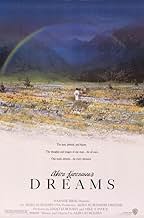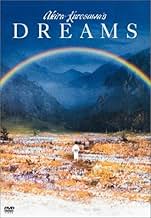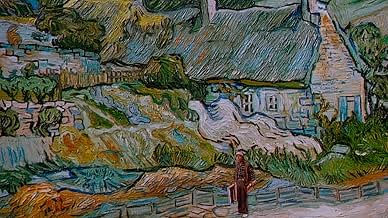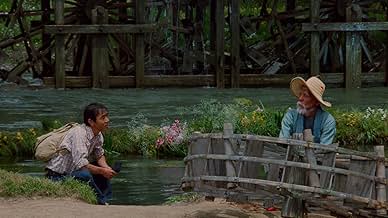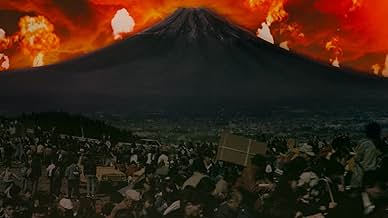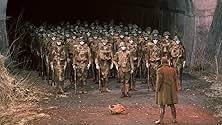Una colección de cuentos basados en los sueños del director Akira Kurosawa.Una colección de cuentos basados en los sueños del director Akira Kurosawa.Una colección de cuentos basados en los sueños del director Akira Kurosawa.
- Dirección
- Guión
- Reparto principal
- Premios
- 3 premios y 12 nominaciones en total
Reseñas destacadas
Sentimentally I love this film, made by Kurosawa when he was 80 and one of his last. The great director gives us eight vignettes that often seem more like messages than dreams, speaking to the danger of nuclear power, damaging the environment, and senseless death in war. Guilt is a recurring theme, and as the film covers childhood to old age, it seems very personal to Kurosawa's own life. The images are often beautiful, and I absolutely loved dream #5, "Crows," where an art student runs through Van Gogh's paintings and meets him. The highlighted work, "Wheatfield with Crows" is so profoundly meaningful to the end of Van Gogh's life that seeing it here in the elderly Kurosawa's work gave me goosebumps. I didn't mind the preachiness that's in several of the other dreams too much, though it did take away from the film's surreal feeling, but the bigger issue was pace, which was almost always too slow. It's a must-watch film for fans of Kurosawa and I'm glad I saw it, but it needing paring down.
"Dreams" is one of the greatest puzzles to hit the screen since Tetris. If you're up for the challenge, you should definitely give it a try. Here Kurosawa presents us with 8 fragments which may seem confusing at first, but ultimately they tell a powerful story of man's evolution beginning at childhood in a traditional setting, taking us through adulthood, war and waste, to a postapocalyptic future that could be called "scifi", and ultimately capping the story with a stunning piece I won't ruin for you.
The story loosely follows a character called "I" as he grows up in his dreams. He is presented as merely an observer, almost like the faceless interviewer in "Citizen Kane," or for you literature fans he may remind you a lot of Dante in the epic "Divine Comedy". That is, he observes humankind through its sins. Aye, don't be fooled by Kurosawa's gorgeous, bright, uplifting visuals; this is perhaps Kurosawa's darkest tale.
The 8 stories are: 1) As a young child, he inadvertantly disrupts a secret ritual of foxes in the forest. 2) Still a child, he meets the ghosts of trees that his family destroyed. 3) Now a young adult, he is the leader of an ill-fated mountain expedition visited by a mysterious spirit. 4) Older yet, past the age of youthful fire, he is a soldier returning from a terrible war and haunted by ghosts of his battalion. 5) Now a middle aged artist, he encounters the ghost of Vincent Van Gogh. 6) Abruptly he finds himself in the middle of a (deliberately) insane disaster flick. 7) The scifi segment where he wakes up in a postapocalyptic future full of cannibal demons (yes, Kurosawa made a zombie flick). And ultimately 8) The one I won't mention because it's for you see how it all ends.
All 8 stories follow the same theme of "I" meeting ghosts who tell of man's sins. Worthy of note is our hero's passivity which is itself one of the failings of man. As "I" grows up and faces increasingly devastating consequences for humankind's shortsightendess, we realize Kurosawa's poignant message. Each "dream" is a stark warning.
If you watch this film, I suggest paying close attention to 1 subtle but important thing. Notice Kurosawa's use of "special effects" because that is the key to a deeper message. In the beginning when "I" is a child, the special effects (forest spirits) are merely people dressed up in elaborate masks--a very childlike way of perceiving fantasy. In the young adult segments, the special effects (ghosts of soldiers) are disturbingly realistic yet stylized. In middle age, the excellent Van Gogh segment, the special effects are magnificently overwhelming, literally engulfing the entire screen. Then for the 2 climactic "scifi" segments, suddenly the effects are almost absurd like a cheesy disaster flick (this was deliberate. Kurosawa even enlisted the assistance of his friend Ishiro Honda who directed a few Godzilla flicks). And we end on the 8th magical segment which has no special effects at all.
Kurosawa was telling us a story through the evolution of visuals, just as much as he was telling us a story of sequential events. If you can follow these and other clues that are peppered throughout, you'll realize that "Dreams" has a very clear path and a very cryptic but powerful story. So put down your sodoku; this is the real deal.
The story loosely follows a character called "I" as he grows up in his dreams. He is presented as merely an observer, almost like the faceless interviewer in "Citizen Kane," or for you literature fans he may remind you a lot of Dante in the epic "Divine Comedy". That is, he observes humankind through its sins. Aye, don't be fooled by Kurosawa's gorgeous, bright, uplifting visuals; this is perhaps Kurosawa's darkest tale.
The 8 stories are: 1) As a young child, he inadvertantly disrupts a secret ritual of foxes in the forest. 2) Still a child, he meets the ghosts of trees that his family destroyed. 3) Now a young adult, he is the leader of an ill-fated mountain expedition visited by a mysterious spirit. 4) Older yet, past the age of youthful fire, he is a soldier returning from a terrible war and haunted by ghosts of his battalion. 5) Now a middle aged artist, he encounters the ghost of Vincent Van Gogh. 6) Abruptly he finds himself in the middle of a (deliberately) insane disaster flick. 7) The scifi segment where he wakes up in a postapocalyptic future full of cannibal demons (yes, Kurosawa made a zombie flick). And ultimately 8) The one I won't mention because it's for you see how it all ends.
All 8 stories follow the same theme of "I" meeting ghosts who tell of man's sins. Worthy of note is our hero's passivity which is itself one of the failings of man. As "I" grows up and faces increasingly devastating consequences for humankind's shortsightendess, we realize Kurosawa's poignant message. Each "dream" is a stark warning.
If you watch this film, I suggest paying close attention to 1 subtle but important thing. Notice Kurosawa's use of "special effects" because that is the key to a deeper message. In the beginning when "I" is a child, the special effects (forest spirits) are merely people dressed up in elaborate masks--a very childlike way of perceiving fantasy. In the young adult segments, the special effects (ghosts of soldiers) are disturbingly realistic yet stylized. In middle age, the excellent Van Gogh segment, the special effects are magnificently overwhelming, literally engulfing the entire screen. Then for the 2 climactic "scifi" segments, suddenly the effects are almost absurd like a cheesy disaster flick (this was deliberate. Kurosawa even enlisted the assistance of his friend Ishiro Honda who directed a few Godzilla flicks). And we end on the 8th magical segment which has no special effects at all.
Kurosawa was telling us a story through the evolution of visuals, just as much as he was telling us a story of sequential events. If you can follow these and other clues that are peppered throughout, you'll realize that "Dreams" has a very clear path and a very cryptic but powerful story. So put down your sodoku; this is the real deal.
Truly one of the most beautiful films I have ever seen. I saw this film for the first time in 1993 and it was placed forever in my mind as one of my greatest cinematic experiences. I agree with what another reviewer said about this film, that it is not for everyone. It is very artistic in that the cinematography carries a lot of the story and some may become bored with it. Hollywood has a way of brainwashing a lot of viewers into needing a lot of dialog or action. If that's what you're after, you wont find it here. You have to use your brain for this one. This movie is Japanese and what little dialog there is, is in subtitled for the American viewer. So you may need to do a little reading. This is not simply a movie; it is several short, amazing stories that stem from the mind of Akira Kurosawa (a genius in my book). One is like a beautiful fairytale and another is a nightmarish fable and still another is a terribly haunting ghost story, there are others but all are done very well. This film needs to be seen in the letterbox format as it was intended. The cinematography, as I said earlier, contributes so much that it should be viewed completely. I really don't know what else to say about this movie except that if you have an artistic streak and like to see how movies can become art I would highly recommend Yume (Dreams).
Going back to what made Akira Kurosawa a star, Dreams is a film driven by a completely original concept. Like Rashomon, this is something that had never been done before. To my knowledge, nobody since has had the skill or guts to make a movie that accurately captures the spirit of........ bizarre Dreams. These stories are filmed and written just like real dreams. They're full of strange events that most of the time make no sense, yet everyone in the story totally believes it to be normal.
My favourite segments are "The Tunnel", as story where a former military commander encounters the ghosts of all the soldiers who died under his command. The Commander explaining why his soldiers died is hands down the best acting in the movie. My second favourite wold be "The Peach Orchard". This is about a young boy that finds a group of living dolls in the fields. The dolls are furious that the boy's family have destroyed all the peach tress in the Orchard. This segment was the most dreamlike. My third favourite would be "Mount Fuji In Red". In that there is a nuclear meltdown. Panic spreads and a few survivors contemplate whether or not to end their lives.
In traditional Kurosawa fashion, this movie is visually breathtaking. Kurosawa films don't just look great, they look unique and interesting. The visuals in Dreams helps create the hypnotic dream-like state. In the "Crows" story, a man enters the world of a Van Gogh painting. Parts of the scenery here are natural landscapes, and parts are made to look like a painting. In "Blizzard" mountain climbers are on the verge of death. They're rescued by a snow spirit. The blinding snow and the sort of slow motion effect when you see the Snow Fairy makes this segment perhaps the most hypnotic images Kurosawa has ever produced.
I wouldn't want anyone to get the idea that this is just a bunch of unconnected segments. Several characters appear in various segments, and some are meant to play back to back. I have to say that Dreams may not be for everyone. I'd recommend everyone alive check it out, though. Some may love it, some may not understand it. I'm on the side of this being one of the last brilliant works of the World's greatest Director.
My favourite segments are "The Tunnel", as story where a former military commander encounters the ghosts of all the soldiers who died under his command. The Commander explaining why his soldiers died is hands down the best acting in the movie. My second favourite wold be "The Peach Orchard". This is about a young boy that finds a group of living dolls in the fields. The dolls are furious that the boy's family have destroyed all the peach tress in the Orchard. This segment was the most dreamlike. My third favourite would be "Mount Fuji In Red". In that there is a nuclear meltdown. Panic spreads and a few survivors contemplate whether or not to end their lives.
In traditional Kurosawa fashion, this movie is visually breathtaking. Kurosawa films don't just look great, they look unique and interesting. The visuals in Dreams helps create the hypnotic dream-like state. In the "Crows" story, a man enters the world of a Van Gogh painting. Parts of the scenery here are natural landscapes, and parts are made to look like a painting. In "Blizzard" mountain climbers are on the verge of death. They're rescued by a snow spirit. The blinding snow and the sort of slow motion effect when you see the Snow Fairy makes this segment perhaps the most hypnotic images Kurosawa has ever produced.
I wouldn't want anyone to get the idea that this is just a bunch of unconnected segments. Several characters appear in various segments, and some are meant to play back to back. I have to say that Dreams may not be for everyone. I'd recommend everyone alive check it out, though. Some may love it, some may not understand it. I'm on the side of this being one of the last brilliant works of the World's greatest Director.
Akira Kurosawa's insights on man's need to harmonize with nature, the costs of war and the bad fruits that nuclear power can bear. This is the first Kurosawa movie I have seen, but I can see how true it is that Kurosawa is a master of creating atmosphere in a film. Such as the dark, post-nuclear apocalyptic world of THE WEEPING DEMON. Or the very first episode when the little boy sees something he is not supposed to see in the forest.
I found THE BLIZZARD rather strange, and you'll see a scary part when the mountainman is having his mirage of the beautiful woman who symbolizes the snowstorm. I'm not sure what the significance of the dog was in THE TUNNEL, but I guess it illustrates the fact that though he was the commander of Third Platoon , he felt like a coward because of his command, his men paid the price.... yet he is guilty of still being alive; he's afraid of the dog.
It ends rather low key, but the last episode THE VILLAGE IN THE WATERMILLS is the most insightful and bold in expressing the movie's theme... of harmonizing with nature, and maybe harmonizing with ourselves.
The procession displays the unity and the communal harmony that the villagers have. And it is the exact opposite of what is grieved about in MOUNT FUJI IN RED or THE WEEPING DEMON. The cinematography is just beautiful. The movie is beautiful and captivating.
Akira Kurosawa's YUME is Grade A- 9/10
I found THE BLIZZARD rather strange, and you'll see a scary part when the mountainman is having his mirage of the beautiful woman who symbolizes the snowstorm. I'm not sure what the significance of the dog was in THE TUNNEL, but I guess it illustrates the fact that though he was the commander of Third Platoon , he felt like a coward because of his command, his men paid the price.... yet he is guilty of still being alive; he's afraid of the dog.
It ends rather low key, but the last episode THE VILLAGE IN THE WATERMILLS is the most insightful and bold in expressing the movie's theme... of harmonizing with nature, and maybe harmonizing with ourselves.
The procession displays the unity and the communal harmony that the villagers have. And it is the exact opposite of what is grieved about in MOUNT FUJI IN RED or THE WEEPING DEMON. The cinematography is just beautiful. The movie is beautiful and captivating.
Akira Kurosawa's YUME is Grade A- 9/10
¿Sabías que...?
- CuriosidadesAkira Kurosawa had trouble getting financing from studios in Japan, blaming much on the political nature of his criticism of nuclear power in the film. He sent a copy of his script to Steven Spielberg, who liked it, and helped get a deal for the film through Warner Bros.
- ConexionesEdited into Gli ultimi giorni dell'umanità (2022)
- Banda sonoraIn the Village
(from "Caucasian Sketches, Suite for Orchestra Op. 10, No. 2")
Music by Mikhail Ippolitov-Ivanov (as Ippolitov-Ivanov)
Conducted by Vladimir Fedoseyev (as Vladimir Fedoseev)
Performed by Moscow Radio Symphony Orchestra
Selecciones populares
Inicia sesión para calificar y añadir a tu lista para recibir recomendaciones personalizadas
- How long is Dreams?Con tecnología de Alexa
Detalles
- Fecha de lanzamiento
- Países de origen
- Idiomas
- Títulos en diferentes países
- Dreams
- Localizaciones del rodaje
- Daio Wasabi Farm, Azumino, Nagano, Japón(The Watermill village)
- Empresa productora
- Ver más compañías en los créditos en IMDbPro
Taquilla
- Presupuesto
- 12.000.000 US$ (estimación)
- Recaudación en Estados Unidos y Canadá
- 1.963.207 US$
- Recaudación en todo el mundo
- 2.970.161 US$
- Duración
- 1h 59min(119 min)
- Color
- Mezcla de sonido
- Relación de aspecto
- 1.85 : 1
Contribuir a esta página
Sugerir un cambio o añadir el contenido que falta



